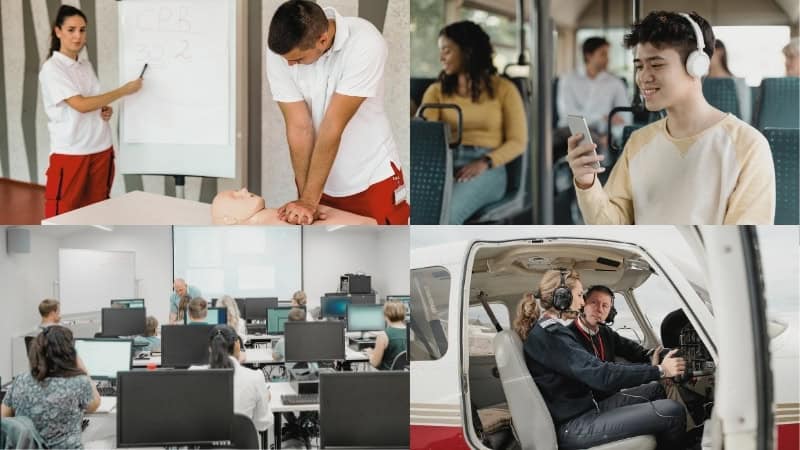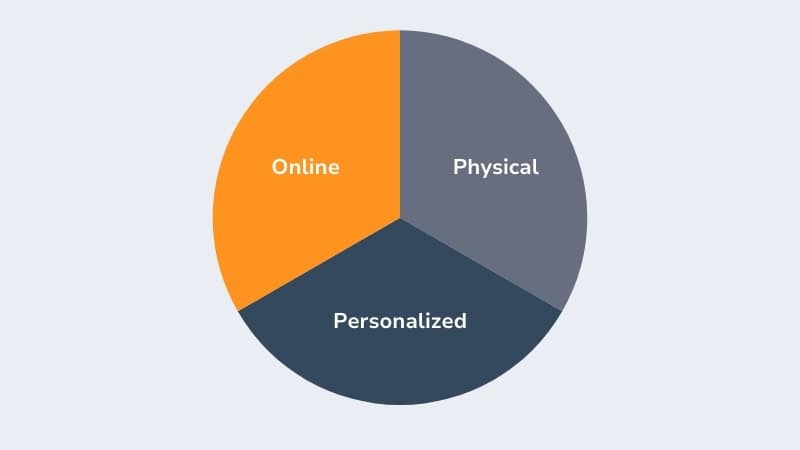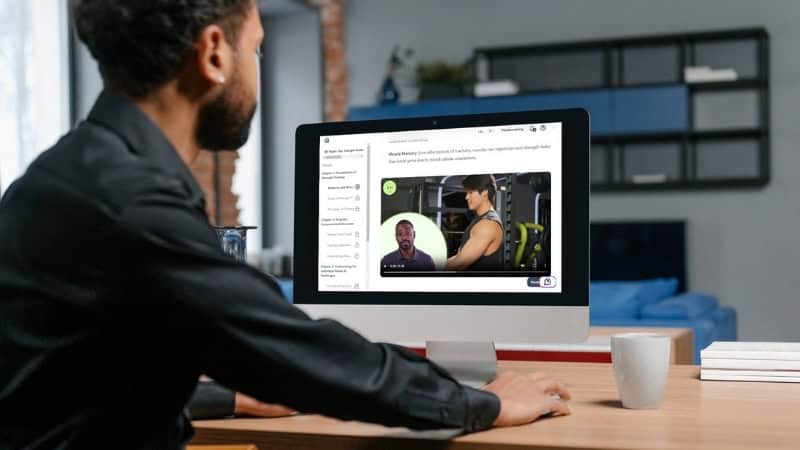Blended learning, also known as hybrid learning, is a method of learning that integrates digital resources with traditional in-person discussion. It is an approach that takes advantage of both forms of learning (and teaching) to make the experience more interactive, enjoyable and effective.
Do you offer courses or upskilling? Explore how you can use the blended learning approach most effectively, and offer your participants or employees the upsides of learning with both digital and hands-on tools.
What is blended learning?
Blended learning is an approach that combines online learning and interaction with physical place-based learning. It includes several methods of learning by combining face-to-face interactions with online activities. It can be structured around a fixed schedule, where some days have physical attendance and on other days it relies solely on digital tools. In other models, there can be a combination of both tools in one day. This might be the case for someone who runs a business that offers an array of different courses to other companies. Then you can integrate your systems for course offering to include both in-person and online features.
Let us deep dive into the meaning behind combining learning techniques, and explore the value of blended learning for course providers and online learning facilitators.
The blended learning approach is a symptom of how we want to gain new knowledge today
The emergence of laptops, smartphones, and tablets make knowledge more accessible and the urge to take advantage of them that much stronger. That is why the blended learning approach is attractive to many, both to users and those who deliver courses, learning programmes and opportunities for upskilling. It is a way of utilising the long tradition of classroom learning, which is carried out in person, in combination with digital learning with the help of modern e-learning tools.

Examples of blended learning
Blended learning is not just an approach for facilitating a productive learning space in traditional classrooms, it is also a way for you as a business or course provider to engage your employees or participants in a flexible and coherent way.
In school
Blended learning is a teaching method where educational institutions combine classroom teaching with online instructions. Many schools and universities see great advantages in offering blended learning and utilising this approach to make learning more flexible for students. Especially during the covid-19 pandemic, we saw a surge in the use of blended learning, but many have since continued to combine physical classroom-based learning with online learning.
In courses
For course providers blended learning is a heavily used approach. If you have the right tools at hand, it can be of great benefit to offer both physical place-based courses and online courses. Many course providers use a training management system (TMS) to administrate and facilitate the courses, while utilising a learning management system (LMS) to offer online learning as well. While a TMS is mainly used to offer physical courses, you can combine it with a LMS and offer your participants a blended learning approach.
In businesses
Many businesses also use a LMS to offer in-house training to their employees. It is a great way to show videos of new routines in practice and step-by-step instructions to new routines. Also, it allows you to get an insight into how they are progressing and make decisions for future development.
How to do blended learning in practice: The 3 components to blended learning
There are some characteristics to blended learning which neatly sums up the meaning behind the concept. According to Michael B. Horn and Heather Staker, this is made up of three components:
Part online
It is offered partly online, which gives the student, employee or participant the freedom to choose when, where and how they take the course.
Part away from home
The remainder is offered in a physical space, away from the home. They underscore the value of offering it outside the home. According to study, there is a value to the participant or student learning in another environment, which is especially organised to be conducive to learning.
Personalised learning path
The learning is structured in a coherent and organised way, for instance by course providers. There is a clear path of what you should learn and which learnings you should take from the course. Oftentimes it is personalised to you or the group you belong to, which is based on your level, qualification or other competences.
Why is blended learning important?
Blended learning is valuable because it allows you to create the necessary balance between online and offline learning according to your preference. This is based on the needs of the learner and the strategy that the teacher has for the learning environment.
By implementing a blended learning strategy, you can promote effective practice and pedagogy. It allows you to take every individual and their needs into consideration and create a course program that is suitable for almost all types of learners.
The course gets personalised and tailored accordingly, and gives you as a training or course provider a better grasp of how to develop the course further. Therefore, blended learning will benefit the one who sits behind the desk – or screen – and the one who organises the course.
Blended learning benefits both the learner and teacher
There are many educational and economic benefits to making learning less formal. To utilise the digital space for learning creates more flexibility for students, businesses and course providers, among others.
Flexible
The flexibility of blended learning is one of the greatest benefits to this approach. For course providers or teachers, they have several options in how they want to structure their course. They have the flexibility to combine digital and interactive learning with traditional tools. For students or participants, they have more freedom to choose a method and potentially increase the amount and quality of the outcome.
Effective
Blended learning offers a multitude of different spheres and spaces for learning. Instead of simply gaining motivation and assistance in a classroom or other physical space, learners can get insights from peers, teachers and instructors in online rooms. It makes learning more collaborative and accessible, which likely enhances the level of engagement.
Personal
Everyone has different methods for learning. You probably know what works best for you, and in the blended learning approach it is possible to amend the modules after every type of learner. Therefore, blended learning is personal and accounts for everyone. As a course provider you can customise and optimise your courses by utilising a TMS system to administrate and schedule in-person events, while also putting in the groundwork for participants to do online learning courses through a LMS system.
Less costly
You might associate high costs with combining a digital system with physical-place learning, but this is not the case. The combination of both tools is a cost-effective and valuable method for cutting spending. Why? Because you can determine yourself how you want to allocate the digital and physical-place learning. Cut down on travel or instruction costs and use the digital tool instead for a period of time, before you hire the instructor for a traditional course.
Interested in giving a TMS or LMS system a go? Get a sense for why you should invest in one.
How to implement a valuable strategy of blended learning?
When getting started with blended learning, it is important – for the teacher or course provider – to set a clear strategy for how it is implemented.
Clear objectives
The strategy should establish some objectives. Start with assessing the needs of the course participant or student. As a training provider you need to forge a pathway that benefits the learner. What are you providing for the participant, what value does that bring to them, and how can you ensure that they learn what you want them to?
Functional course design
From there, you can use your expertise as an instructor to create an appropriate structure to the course. You should ensure that the structural course design is set up according to the course level. This is determined by the participants’ level of knowledge and their desired outputs or outcomes for completing the course. It is imperative that you manage to engage the participants and make the learning process interactive and both challenging and fun.
Appropriate balance between digital and physical learning
Training providers need to create a valuable balance between digital and traditional learning, and allow for flexibility throughout the programme. You can establish a strategy and change it if other, more pressing needs pops up or when evaluations from participants start to come in.
Be prepared to gear up and down
Inherent in any strategy is the ability to adjust it as you go. You do not want to do too much, too soon or create a learning environment where the learning curve is too steep, the design is too firm or the balance is off. Implement the new blended learning framework according to your course participants and do regular feedback sessions and gather course evaluation data to better the learning experience going forward.
A platform for blended learning: Must-have tool to facilitate blended learning courses
Are you ready to offer blended learning, but maybe need some more guidance on how you can offer blended learning in your training or course business? You’ve come to the right place. In this section we will guide you through the necessary tools you need to check off when choosing a system that facilitates blended learning.
A learning management system (LMS) or another learning platform is a must if you want to implement a successful blended learning strategy. This enables you to create a virtual online sphere for training and learning, which gives you the ability to offer courses and training sessions in a flexible way.
User-friendly tools
The LMS needs to be a tool that suits your course participants. By this we mean that the LMS should be easy to use and reliable. In addition, it should not be dated or lack important features.
Engaging content
The system should support making learning and training more fun and engaging. One way to accomplish this is to integrate videos in the online course. You need a LMS that allows you to integrate videos, which elevates the learning experience.
While video training makes the whole training session more dynamic, a lot can be accomplished through text and images. You need a LMS that enables you to customise the course offer, where you can edit text, images and other content to create engaging course material.
Accessibility
It is important that you have a system that supports multiple devices. Inherent to blended learning is the option to choose when, where and how you take the course. Therefore, a LMS that you can access from anywhere, on any device, is imperative.
Seamless integration
To make the process even smoother, it is valuable to integrate the LMS with a TMS and other course administration tools. This allows you to accept payment or keep track of sign-ups in a seamless way. When you integrate the systems, you create a better working flow that will prove to be valuable in every step of the process.
Apply blended learning with a LMS
To combine learning approaches is a powerful way of moving into the digital world. Take advantage of your existing solutions for organising courses and inspire more learning by building an online community.
In FrontCore we offer platforms for blended learning. You can use our learning management system (LMS) to simplify and boost e-learning efforts. This is a tool you can use for in-house training, which allows you to build online courses that can be organised wherever and whenever.
For training or courses you can use the training management system (TMS) to administrate courses and integrate it with LMS to facilitate online and physical-based courses.
Blended learning is worth the investment.
Did you like this article? Don't forget to share it:










0 Comments